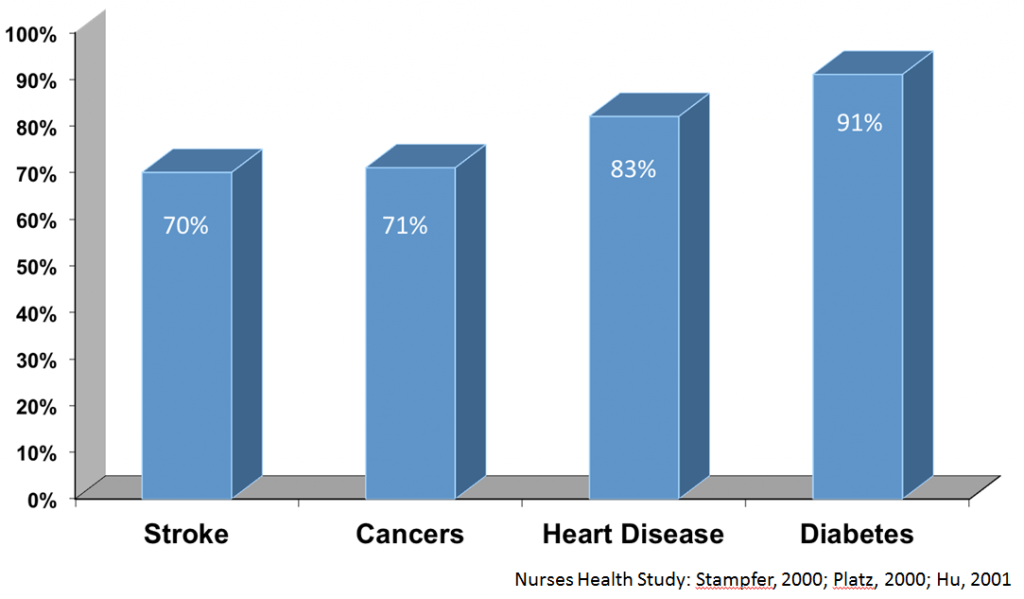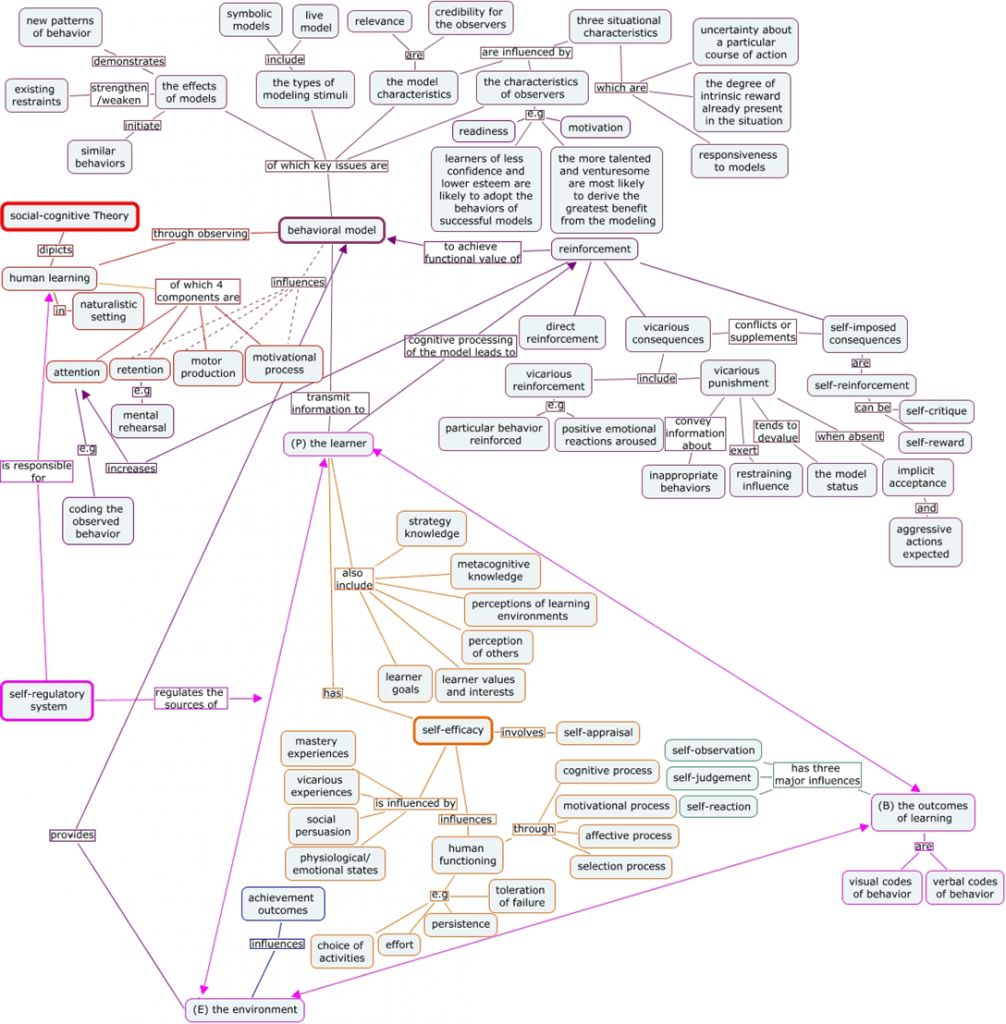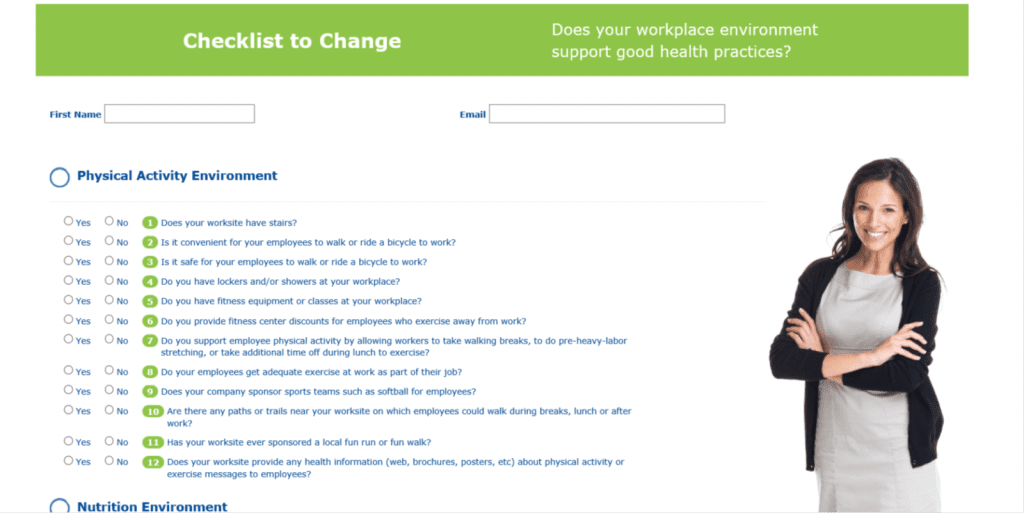How the Best Worksite Wellness Programs Change Behavior

Behavior change is the key to having a successful wellness program. The best worksite wellness programs keep the focus on the need to help employees adopt and maintain healthy behaviors.
Behavior change is the key to minimizing health risks, lowering the prevalence of chronic disease, and reducing employee related expenses. It is impossible to have good health unless you have healthy behaviors.
Wellness Requires Healthy Behaviors
There are many factors that determine how healthy we are, but none of them are as important as our behaviors. Large epidemiological studies that include hundreds of thousands of individuals give us all the information and rationale we need to keep our focus on helping employees change behaviors.
Between 70-90% of all strokes, heart attacks, cancers, and type II diabetes are directly related to what we eat, whether or not we exercise, and whether or not we use tobacco.
This means that the majority of chronic diseases that we suffer from are caused by making poor dietary choices, not moving around enough, or consuming tobacco products. If lifestyle choices explain 70-90% of all chronic diseases then what explains the rest of the chronic diseases not covered by this research?

That’s what makes workplace wellness programs so crucial. We know that certain behaviors are behind declining health, which ultimately leads to high healthcare costs. This makes changing employee behavior through positive wellness programs in the workplace a big player in decreasing those health care costs.
The Influence of Genetics is Small
There are other non-modifiable factors that can influence chronic diseases. While genetics can contribute to chronic diseases, they typically only explain a small portion of the overall risk. For instance, genetics may account for just 3-6% of the chronic diseases. Additionally, environmental factors such as where we live, the air we breathe, exposure to toxins, and workplace hazards that can have an impact on chronic diseases.
Although some individuals may have a genetic predisposition to conditions like high blood pressure, diabetes, or high cholesterol, it’s uncommon for most people to have a familial tendency toward a specific chronic disease. Often, individuals may attribute their family history to a perceived genetic risk.
They may say, “my brother has heart disease, my mother has heart disease, my father has heart disease, and we think that some of our grandparents also had heart disease. I must live in a family that has a high genetic risk for heart disease. Clearly, I must have some kind of heart disease gene.”
While it certainly is possible that this individual has inherited a genetic predisposition towards cardiovascular disease, it is essential to recognize that shared lifestyle choices among family members can also play a significant role. For instance, individuals within the same family may reside in the same community, follow similar diets, engage in similar exercise routines, and may or may not use tobacco products.
Therefore, distinguishing whether a family’s history of heart disease is due to genetics or shared lifestyle choices can be challenging. However, ultimately, the cause may not be as crucial as the collective effort to adopt healthier habits and mitigate risk factors for chronic diseases.
The Solution
The solution is the same: we need to help individuals adopt and maintain healthy behaviors. In some cases, risk-reducing medications are required, and taking a medication is a behavior.

Medical professionals and worksite wellness programs face the same challenge: help individuals make healthy choices. Consider elevated health risks such as high blood pressure, high blood glucose, or high blood cholesterol. Most of these risks are caused by poor nutrition, lack of physical activity, weight gain, stress, tobacco use, poor sleep habits, and other health behaviors.
Elevated health risks lead directly to the development of chronic diseases—diseases that take a lifetime to develop and which ultimately end in death. These are the major killers within our society and they include cancer, cardiovascular disease, Alzheimer’s disease, type II diabetes, stroke, digestive disorders, and many others.
IIndividuals who have chronic diseases require intensive medical interventions, may have a poor quality of life, and may not be as productive as they could be. This relationship between behavior and employee related expenses and poor health is easy to understand and accurate.
The scientific evidence that links unhealthy behaviors with disease, elevated health risks, elevated health care costs, and poor quality of life is extensive. This research also helps us understand why worksite wellness programs that focus on changing employee behavior are more likely to be successful.
The challenge for all of us is to figure out how to get people to adopt and maintain those healthy behaviors. Changing health behaviors is perhaps the most challenging exercise any of us will ever complete and work site wellness programs can help.
Behavior Change Theory Meets Reality
There is an equally enormous body of scientific literature that explains how human behavior works and how it can be changed. This literature describes complex behavior change models which accurately describe every nuance and complexity of the behavior change process.
There are literally tens of thousands of published research papers on behavior change. You’ve probably heard of some of these behavior change models – like the amso model.
Others include the stages of change model, the trans-theoretical model, the precede-proceed model, the social cognitive theory and many others. They are complicated explanations of how humans change behaviors. Here is a diagram of the social cognitive theory of behavior change:

Scientifically, this and other models do an outstanding job of explaining the complexities of human behavior but from a real-world perspective they are almost worthless. They are so complex that it is difficult to implement them for workplace health initiatives.
Few, if any worksite wellness programs, will ever be successful building behavior change programs using every detail of these models, no matter how accurate.
Faced with budget restrictions and personnel limitations, it is unrealistic to expect a work site wellness program to implement any kind of programming based on these models. These real-world barriers have created a need for a more simplified, understandable, and practical approach to making real strides with wellness at work. Luckily for us, there is a simplified version of this.
How Workplace Wellness Programs Change Behaviors
Not too long ago, Dr. Michael O’Donnell introduced a simplified behavior change model we mentioned briefly above. It’s designed to help wellness at work actually improve employee health behaviors. It’s called the AMSO model, (Awareness, Motivation, Skills, and Opportunities). This simple model helps worksites create effective worksite wellness programs that improve employee health.

The four components are pretty easy to understand. Awareness and education is the “what” of behavior change. The motivation is what drives us to change. The skills and tools portion is the “how do I do this?” part, and the culture and environment part is a conglomeration of environmental changes, policy changes, and support from others that all help us to be successful.
Which one do you think is the most powerful and helps people adopt and maintain healthy behaviors? As you can see in the figure above, the most important part of the behavior change process is actually culture and environment. About 40% of the success of behavior change happens when we establish a supportive environment and when we receive peer support from others.
The least important aspect of this model is awareness and education at just 5%, yet this is where most workplace health programs spend most of their time and budgets. Let’s take a deeper look into each one of these components.
Awareness and Education
All of us are familiar with this part of the behavior change process. This is the easy part of wellness at work.
Workplace wellness programs use health risk appraisals, biometric screening, posters, flyers, videos, books, email notifications, text messages, payroll stuffers, Internet sites, magazines, lunch and learns, special speakers, company newsletters, blogs, and many other forms of communication to create awareness of wellness at work.
These company wellness programs examples help individuals become aware of and educated about good health practices. They help us understand what health risks are and what it really means to have an elevated health risk. They help us learn whether or not we have elevated health risks or unhealthy behaviors.
This blog is an example of how awareness and education can work. As you read and look at the images you are becoming aware of and educated about the WellSteps approach to successful wellness programs in the workplace.
I am trying to convince you that the success of your wellness program at work will hinge upon whether or not you’re able to help employees improve health behaviors.
Hopefully the content you’re reading is helpful, but just providing awareness and education is not going to be enough to help you, the reader, implement an effective behavior change program. You are also going to need to be motivated.
Motivation
I have already written extensively here and here about the need to have the right kinds of motivation in wellness programs in the workplace. These are the exact steps we use at WellSteps with all of our clients.Most workplace health programs encourage employees to participate in a variety of health promoting activities.
The use of incentives is just one strategy that can be used to motivate employees. All of us have been able to change our behaviors at one time or another.
We change behaviors constantly and some of those behaviors become daily habits. Think about the last major behavior change you implemented.
What motivated you to change that behavior? Why did you do it? Chances are pretty good that the last time you changed your behavior you did not do it because someone was offering you some kind of monetary incentive.
We change behaviors for a lot of reasons. Peer pressure, love, the desire for something better, fear, and just wanting to improve our lives can provide ample motivation to change.



Here are three images that can be used in changing behavior in the workplace. Not one of them is associated with a monetary incentive and yet they can be very powerful agents of change.
Skills and Tools
This is the “how” of behavior change. It is one of the most important aspects of successful behavior change, and it is the one that we perhaps neglect the most. Biometric screening is great at helping people understand their current health risks but unless that screening helps people with the skills and tools they need to reduce their elevated health risks, the screening won’t do much to improve employee health.
The Skills Required
Awareness and motivation are important steps to start the behavior change process but without the requisite skills and tools failure is inevitable. As wellness professionals we need to show people exactly how to change behavior. We need to show them how to overcome the barriers that are preventing them from living healthy lives. To have a healthy diet individuals must know how to shop for, purchase, and prepare healthy foods.
Cooking healthy foods is a skill. Learning to understand nutrition labels and finding good tasting produce is a skill. Learning how to grow a garden is a skill. Learning how to have business meetings and still order healthy foods is a skill.

Those who have healthy lifestyles have mastered most of the skills needed to be healthy. People with a healthy lifestyle know how to cook vegetables in a way that makes them taste good.
They know how to identify foods that are good for them and foods that should be avoided. They know how to bargain shop for healthy foods. They know how to identify high-calorie foods and to control portion sizes.
They have learned that many times they can share a meal with someone else and still have plenty of food left over. All of these are specific skills that have to be demonstrated, learned, and mastered if behavior change is to become permanent.
There are skills for healthy nutrition, exercise, stress management, relaxation, conflict management, and tobacco avoidance. Wellness programs need to demonstrate and teach the skills that people need to have healthy behaviors.
How to Develop Skills Via Workplace Health Programs
Skill learning can take place during ‘lunch and learns’ or by viewing the web. Introducing wellness at work by having employees bring in food for a healthy potluck will expose employees to different ways of cooking healthier options.
One of our more popular WellSteps campaigns uses the Stop and Go Fast Food Nutrition Guide. It’s FREE to everyone with a mobile phone. This campaign gives employees the skills they need to navigate the fast food world and make the healthiest selections possible.

Tools for Behavior Change Strategies
In addition to skills, sometimes we need specific tools to help us. Thai food is a delicious way to eat a lot of vegetables. There are certain tools you need to make Thai food.
You need to have the right spices, a good skillet, and the right recipes. Employees who exercise on a regular basis may need access to a gym, exercise clothes, exercise shoes, sports equipment, or even a company-sponsored sports team to encourage them to participate.
There are lots of tools that are at our disposal to help us eat right and exercise regularly. You don’t necessarily have to buy all the required tools for your employees but you do have to educate them about how the tools can be used and where they might find them.
For example, employees who want to walk at lunch could use a map of the local walking trails and paths to help them find the right location and distance. A map of the local walking trails or paths is a tool that can help them accomplish their goal.
Culture and Environment
The last step of the behavior change process is the most important one. It’s not just about changing the culture and environment, it’s about altering policies of the worksite, creating social support, and changing the physical environment.
It’s the most important aspect of worksite wellness programs because it has the largest impact long-term on helping people have healthy behaviors.
Change Breeds Change
Nationally, about 21% of the population smokes cigarettes, but in California the smoking rate is about 9%.
Why is the smoking rate in California so much lower? The main reason is because the state of California has implemented a variety of smoking policies, more than any other state.
There are few places where a person can smoke in California. You cannot smoke at the beach or in a public park; your car and your own home are about the only places you can legally smoke.
Strict policies are not necessarily the solution to having successful worksite wellness programs, but carefully crafted and supportive policies are.
Supportive Policies Motivate Wellness at Work
Having healthy food options in a company cafeteria is a policy that can greatly influence workplace health habits.

No one is being forced to eat healthy foods, but at least the healthy foods are present, and in many cases they are sold at a lower price point. This workplace wellness policy makes it easier for people to purchase and consume healthier foods over less-than-healthy foods.
Creating health-promoting policies and environments at work is something employees can participate in. The worksite wellness committee needs to meet often to talk about how to create a healthy environment at work. This discussion can include changes in policy and actual changes in the environment.
Changing behavior in the workplace can include providing opportunities for employees to be physically active, mapping out walking paths or bike paths, establishing tobacco free zones and a tobacco policy at work. It includes helping employees find a safe place to exercise, or providing them with convenient access to healthy, inexpensive foods. There are a variety of things every company can do to change the policy and environment in such a way that promotes wellness at work.
Checklist to Change
To help employers decide what changes to make and what their options are we created a free online tool called the Checklist to Change. This tool starts with a really short worksite wellness audit that helps you identify the things you’re doing well in the policy and environment changes that you might still need.
Then it gives you information and resources that you and your wellness committee will need to implement these changes. Any worksite can use the checklist to change. It is located here.

We encourage every WellSteps client to use the Checklist to Change. Every quarter the wellness coordinator and the wellness committee will use the results from the checklist to identify one policy or environmental factor that they can change in the next three months. Using this process every client is able to improve their workplace health environment and policies by making small and consistent changes and improvements, as well choose the right worksite wellness programs that can help them succeed.
One or two small environmental changes may not initially have a big effect on employee behavior. But after a consistent effort over two or three years, anyone visiting the worksite instantly recognizes that employee health is supported at this workplace.
Humans are Social Beings
Humans are very social creatures. We depend upon each other for many things, including our attempts to be healthy. Spouses and significant others are perhaps the most important part of a successful behavior change effort. It is possible to change behaviors without the help of others, but it is extremely difficult.
It is easier to be healthy when someone is joining us on this journey. Social support can include more than just spouses and significant others. It can include coworkers, professional colleagues, friends, neighbors, church groups, and even pets.
Yes, a dog can provide an enormous amount of encouragement and support for taking a daily walk. Dog owners know the drill. Dogs love to go for walks and dog owners feel obligated to take them. This is called puppy peer pressure.

Obviously it costs more money to include spouses and significant others in workplace wellness programs. But it’s also likely you are paying for the medical expenses of spouses and significant others already. If the goal of worksite wellness is to reduce employee medical expenses, it only makes sense to allow all plan members to improve their health behaviors.
Spouses and significant others should be able to participate in your incentive plan, team competitions, lunch and learns, and they should be receiving your wellness newsletter and emails. They should be invited to participate in as much of the workplace health program as possible. The best worksite wellness programs recognize the importance of social support and do everything they can to help employees get help from others.

How Effective Wellness Programs Work in the Real World
WellSteps uses technology to facilitate the behavior change process. Rather than rely on a stand-alone wellness web portal for information, the worksite wellness program is an interactive behavior change platform that uses social media, video, weekly tasks, quizzes, team competitions, goal-setting, reminders, text messaging, push notifications, and incentive tracking to educate, motivate, and provide health promoting skills and tools.
This leveraged technology platform provides a careful blend of user convenience and face-to-face interactions with other program participants. Behavior change campaigns are 4-6 week challenges designed to improve workplace health and build self-efficacy by reducing the behavior change process to manageable weekly tasks.

They may include short videos, simple quizzes, games, materials, wearable device integration, demonstrations, team competitions, behavior change strategies, incentives, and peer support.
Popular Workplace Wellness Programs Examples by WellSteps
In the WellSteps Move It Coast to Coast campaign, participants work together as a team to support each other by engaging in physical activity as their team competes with others to “race” across the United States.
This campaign uses each of the behavior change strategies and social support to help all team members increase physical activity and applies technology to track progress and enable communication within and between teams.
Besides the use of technology, this worksite wellness campaign requires considerable leadership support for work site wellness. Company leaders must decide to make creating wellness at work a priority. Budgets are created and time is allotted to all employees and significant others to help them with everything they need to change behaviors. Four months before any behavior change program was launched, a marketing campaign was initiated.
These campaigns may include visible leadership support for wellness programs in the workplace, posters, postcards, emails, newsletter articles, blogs, and department announcements. Introduction to and explanation of the wellness program is made to all employees during required work meetings.>
Throughout the year, the wellness committee and company leadership are engaged in improving the worksite culture and environment by making it easier to be healthy. Every aspect of every behavior change campaign is guided by the AMSO model of behavior change.
Evidence That in the Best Worksite Wellness Programs Behavior Change is a Success
After spending the majority of my adult life researching the effectiveness of workplace wellness programs, it was easy to see that the behavior change approach to wellness was the only realistic approach that would work. The scientific literature supporting the effects of behavior change is overwhelming.
The challenge has been to integrate this science into the worksite setting. WellSteps and the nation’s best worksite wellness programs have embraced the AMSO model. It is the only model we use with our wellness programs.
Everything we do is grounded in at least one of the four main features of this model. Our entire business model is based on the premise that this model changes employee health behaviors, reduces health risks, and produces positive wellness outcomes.


After 10 years and dozens of research publications we now have proof that this approach to wellness at work – works. Not only have we published a variety of real-world research publications, but we recently received the Koop award, acknowledging this program as the best wellness program in the United States.
So What?
If the goal of your worksite wellness program is to improve employee health and reduce employee related expenses, the only realistic solution will require helping employees adopt and maintain healthy behaviors. This is how wellness programs work if they are to be effective.
Behavior change is the secret to success for all of the best workplace wellness programs. Programs use awareness and education, motivation, skills and tools, and changes in the environment and support from others to help employees create new, healthy habits.
Successful behavior change is hard to do, but it is the only way wellness at work will produce positive wellness outcomes.
Frequently Asked Questions
What are Some Examples of Occupational Wellness Activities?
At WellSteps, we’ve introduced a long list of occupational wellness activities that motivate employees to participate in healthy and positive workplace behavior.
This extensive list includes:
- Feel Fitness: This campaign encourages employees to increase their weekly exercise regimen by 15 minutes each week.
- Get Your Move On: Creates friendly competition to encourage employees to participate in any form of exercise they enjoy.
- Good to the Bone: This campaign is a great example of encouraging employees to work on certain aspects of their health – it focuses on bone strength and the prevention of osteoporosis.
These are just a few examples of how WellSteps focuses on building work site wellness through motivation and education.
What is Worksite Wellness?
What is worksite wellness to a small business versus an enterprise company? The differences lay only in the number of participants. No matter what size your business is – if you: a- are providing health insurance to employees, and, b – care about the health and productivity levels of said employees – then, you’ll want to invest in a workplace health program
When your staff is healthy and happy – it’s been proven that productivity goes way up. There’s a correlation so deeply intertwined that businesses have been forced to pay attention. Occupational wellness activities are a great way to introduce wellness at work. Click here for a list of campaigns from WellSteps.
Where Can I View Company Wellness Programs Examples?
Take a look at our challenges as well as our campaigns. These are two different types of company wellness programs examples but they both encourage positive workplace behavior.
Campaigns: Proven to be a catalyst to changing behavior in the workplace, campaigns are part of WellSteps solutions but can also be purchased a la carte. They include everything you need to encourage wellness at work including marketing, an online program center, a campaign kit, incentives, and more. For a full list, visit our campaign page here.
Challenges: Best described as gamified behavior change strategies that encourage friendly workplace competition. Challenges are also part of WellSteps solutions but can be purchased a la carte as well. These work site wellness initiatives include marketing, an online program center, games and competitions, and more. For a full list, visit our Challenges page.
How to Effectively Introduce Worksite Wellness for the First Time
As a first time introduction to wellness at work, you want to make sure you get everything right from the marketing down to the implementation. The first impression your employees will receive could impact the performance of your campaign and even discourage future participation. That’s why it’s so important to work with companies that specialize in workplace health that also have proven success rates. Visit our solutions page to learn more about our award winning workplace wellness programs.
We strongly believe in changing employee behavior in a changing workplace – that means offering employees the skills and tools they need with wellness at work. Consider minor policy changes that will turn into changing employee behavior – this could be as simple as adding fresh fruits and other affordable healthy snacks at your company cafeteria. That simple change will give employees the option they never had to eat healthy at work.





